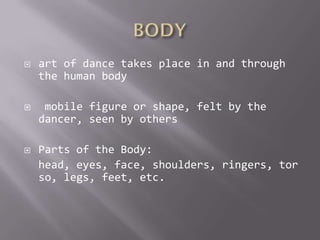Elements of composition
- 1. In Dance
- 2.  art of dance takes place in and through the human body  mobile figure or shape, felt by the dancer, seen by others  Parts of the Body: head, eyes, face, shoulders, ringers, tor so, legs, feet, etc.
- 3.  Whole Body:  body shape symmetrical/asymmetrical, rounded, twisted, angular, arabesque  body systems: muscles, bones, organs, breath, balance, ref lexes  inner: senses, perceptions, emotions, thoughts, int ention, imagination, identity
- 4.  refers to the force of an action and can mean both the physical and psychic energy that drives and characterizes movement  Attack: sharp/smooth, sudden/sustained  Weight: Strength: push, horizontal, impacted Lightness: resist the down, initiate up Resiliency: rebound, even up and down
- 5.  Flow: free, bound, balanced, neutral  Quality: flowing, tight, loose, sharp, swinging , swaying, suspended, collapsed, smoot h
- 6.  1. sustained movement - smoothly, continuously, with flow and control  2. percussive - explosive or sharp  3. vibratory - trembling, shaking  4. swinging - traces an arc or curved line in space - body relax - repetitive
- 7.  5. suspended - hover in space - creates an illusion of defying gravity  6. collapsing - release of tension - performed at a slow or fast tempo
- 8.  http://opd.mpls.k12.mn.us/Energy  http://opd.mpls.k12.mn.us/Body  Minton, S. (1943). Choreography: A Basic Approach Using Improvisation.








